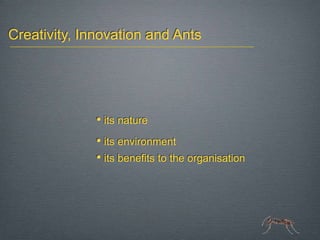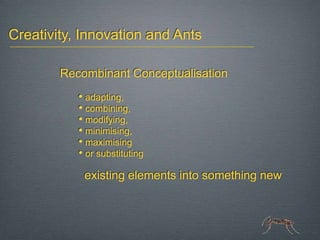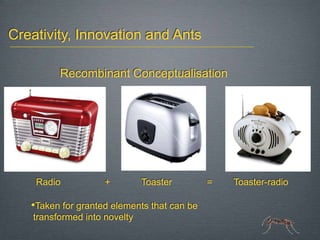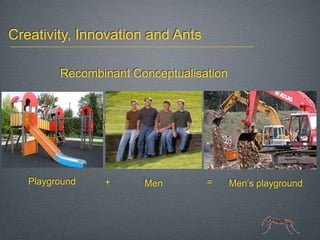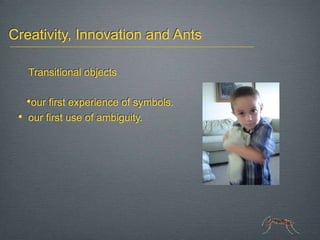Creativity, Complexity Talk
- 1. Creativity, Innovation and Ants • its nature • its environment • its benefits to the organisation
- 2. Creativity & Innovation Space Shuttle & Hubble Telescope footage
- 4. Creativity, Innovation and Ants Recombinant Conceptualisation • adapting, • combining, • modifying, • minimising, • maximising • or substituting existing elements into something new
- 5. Creativity, Innovation and Ants Recombinant Conceptualisation Radio + Toaster = Toaster-radio •Taken for granted elements that can be transformed into novelty
- 6. Creativity, Innovation and Ants Recombinant Conceptualisation •Taken for granted elements that can be transformed into novelty Playground + Men = Men’s playground
- 7. Creativity & Innovation Recombinant Conceptualisation
- 8. Lil’ Pod dinsoaur footage
- 9. Creativity, Innovation and Ants Recombinant Conceptualisation StarWars
- 12. Creativity, Innovation and Ants Transitional objects
- 13. Creativity, Innovation and Ants Transitional objects •our first experience of symbols. • our first use of ambiguity.
- 14. Creativity, Innovation and Ants neurotic- defensiveness innovation Disorder creativity Order genius psychosis insanity chaos cognitive entropy boundary
- 15. Creativity, Innovation and Ants The reasonable man adapts himself to the world; the unreasonable one persists in trying to adapt the world to himself. Therefore, all progress depends on the unreasonable man. George Bernard Shaw
- 16. Creativity, Innovation and Ants Alexander Fleming1881 -1955
- 17. Creativity, Innovation and Ants Penicillium notatum
- 18. Creativity, Innovation and Ants
- 19. Creativity, Innovation and Ants quot;When I woke up just after dawn on September 28, 1928, I certainly didn't plan to revolutionize all medicine by discovering the world's first antibiotic, or bacteria killer,quot; Fleming would later say, quot;But I guess that was exactly what I did.quot; - Alexander Fleming
- 20. Creativity, Innovation and Ants Recombinant Conceptualisation + What have these two thing got in common?
- 23. Creativity, Innovation and Ants Recombinant Conceptualisation +
- 24. Creativity, Innovation and Ants Recombinant Conceptualisation
- 25. Creativity, Innovation and Ants Rules of social insects • learn and adapt • build in redundancy• self-organize •evolve at all costs
- 28. Complex adaptive systems The domain of evolution Complex adaptive systems contain a great number of interacting elements or agents... ...that interact with each other according to sets of rules... ...that might small changes in the basic conditions, but which can produce profound and unpredictable changes to the whole system......requiring robust systems to have built- in redundancy, making fail possible without destabilizing the whole system.
- 29. Kauffmann footage Prof. Stuart Kauffmann
- 30. Fitness landscape Loins and antelope footage
- 31. Creativity, Innovation and Ants Fitness landscape
- 35. Cells; •Should be allowed time on a regular basis to come together to consider issues germane to the organisation in the most creative ways possible •Should be materially rewarded for their work. •Should be free to work in any way they see fit, and be allowed total freedom from any outside interference •The problems they look at should be high level issues, with the attendant responsibilities that entails •They should be encouraged to be as creative as they wish, even if their ideas look hopelessly naïve or unworkable. •It should be a “safe-fail” environment, as opposed to a “fail- safe” one. •The cells only report to management if consensus is reached about an idea or process, or at the completion of the cells work life.
- 36. But there are some very strict rules: • The cells can not comprise more that 7 people, and ideally not more than 5. • They are only allowed to communicate their work to 2 other cells, and only then if doing so involves the sharing of information likely to assist the other cells with their own creative issues • Members of each cell should have diverse interests, and should not be friends or close working colleagues • Each cell should have a limited life, disbanding after a period of 3 to 6 months, with the members going into new cells, comprised of people who are not close friends or colleagues.

